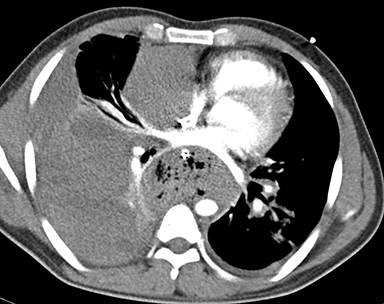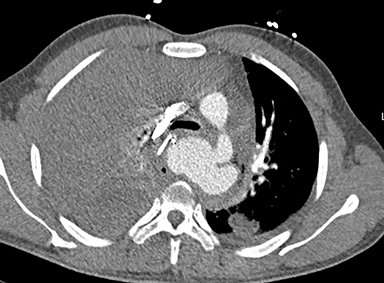Aortic pseudoaneurysm caused by ingested foreign body
Images




CASE SUMMARY
A 29-year-old Asian male presented to the emergency room with history of fever and chest pain for one week followed by sudden collapse. On examination, the patient had a weak pulse with tachycardia, low blood pressure and decreased air entry on the right.
IMAGING FINDINGS
A portable chest radiograph performed at the time of initial presentation demonstrated a large right pleural effusion with suspicion of mediastinal air.
Emergency CT scan of the chest was immediately performed to evaluate the cause of pleural effusion and sudden deterioration of the patient.
The CT scan demonstrated a large right hemothorax with atelectasis of the underlying lung (Figures 1-3). There was also a small left pleural effusion with areas of consolidation in the left lower lobe. A heterogenous collection of air and fluid was identified in the posterior mediastinum displacing the heart anteriorly, suggestive of mediastinitis/ mediastinal abscess (Figures 1,3). There was a 7 x 5 cm pseudoaneurysm arising from the proximal descending thoracic aortic just distal to the origin of the left subclavian artery (Figures 2-4). A 3 cm linear radiopaque density was identified adjacent to the mid thoracic esophagus suggestive of a foreign body, possibly a chicken bone (Figures 2,4). No active contrast leak was noted. No definite aorto-esophageal fistula was identified on the scan.
The diagnosis of perforated esophageal foreign body complicated by mediastinal abscess and aortic pseudoaneurysm resulting in massive hemothorax was made. The patient was immediately shifted to the operating room but could not be successfully resuscitated.
DIAGNOSIS
Perforated esophageal foreign body complicated by mediastinal abscess and aortic pseudoaneurysm
DISCUSSION
Ingested foreign bodies impacted in the esophagus are commonly encountered. Serious complications arising from ingested foreign bodies are, however, rare. Esophageal penetration caused by accidental swallowing of foreign body is unusual, with the reported incidence being 1% to 4%.1 Nandi et al reported that among 2,394 cases of foreign body ingestion, only 25 (1%) of patients had esophageal perforation caused by ingestion of fish or chicken bones, and two of these patients developed aorto-esophageal fistula.2 They found a wide variety of objects retained in the esophagus, but fish bones were the most common (60%) and chicken bones the second most common (16%).
Foreign bodies most commonly perforate the cervical esophagus.2 The second most common site for perforation is at the level of the aortic arch where there is increased risk for fatal vascular complications, as seen in our case. Apart from aorta-esophageal fistula, other rare cardiovascular complications include subclavian-esophageal fistula, and pericardial perforation with cardiac tamponade.3,4
The patient usually presents with chest pain, pain on swallowing, sentinel hematemesis, and massive upper gastrointestinal hemorrhage5,6 secondary to aorto-esophageal fistula. In our case, the patient presented with sudden collapse due to rupture of the pseudoaneurysm and massive hemothorax.
Esophageal perforation by foreign body allows introduction of pathogens into the mediastinum, which results in life-threatening mediastinitis. The wall of aorta is weakened and friable due to the surrounding inflammatory process, and leads to formation of an aortic pseudoaneurysm.7 The predilection site of the pseudoaneurysm is the aorta isthmus.8 This arises because the aorta isthmus is where the esophagus and the aorta are in close proximity; thus, foreign bodies are likely to become stuck and cause perforation. Subsequent infection of the esophagus and/or mediastinum could further contribute to the formation of aortic pseudoaneurysm.9
Aorto-esophageal fistula that develops after foreign body–induced esophageal perforation is usually fatal; the accompanying aortic pseudoaneurysm and esophagitis and/or mediastinitis must be managed promptly. Early diagnosis and accurate localization of the lesions can contribute to a better prognosis. CT examination is a simple and effective method by which to visualize the pseudoaneurysm and its adjuvant structures.10
CONCLUSION
Foreign bodies in the esophagus can occasionally result in complications. A rare complication is aortic pseudoaneurysm secondary to mediastinitis, which can have catastrophic consequences.
REFERENCES
- Scher RL, Tegtmeyer CJ, McLean WC. Vascular injury following foreign body perforation of the esophagus: review of the literature and report of a case. Ann Otol Rhinol Laryngol. 1990;99:698-702.
- Nandi P, Ong GB. Foreign body in the oesophagus: review of 2394 cases. Br J Surg. 1978;65:5-9
- Loh KS, Tan KK. Subclavian-oesophageal fistula as a complication of foreign body ingestion: a case report. Ann Acad Med Singapore. 1998;27:277-278.
- Sharland MG, McCaughan BC. Perforation of the esophagus by a fish bone leading to cardiac tamponade. Ann Thorac Surg. 1993;56:969-971.
- Skinner DB, Little AG, DeMeester TR. Management of esophageal perforation. Am J Surg. 1980;139:760-764.
- Hunt I, Hartley S, Alwahab Y, Birkill GJ. Aortoesophageal perforation following ingestion of razorblades with massive haemothorax. Eur J Cardiothorac Surg. 2007;31:946-948.
- Sia KJ, Ashok GD, Ahmad FM, Kong CK. Aorto-oesophageal fistula and aortic pseudoaneurysm caused by a swallowed fish bone. Hong Kong Med J. 2013 Dec;19(6):542-544.
- Chen AP, Yu H, Li HM, Xiao XS, Liu SY. Aortoesophageal fistula and aortic pseudoaneurysm induced by swallowed fish bone: a report of two cases. Cardiovasc Intervent Radiol. 2011 Feb;34 Suppl 2:S17-19.
- D’Costa H, Bailey F, McGavigan B, George G, Todd B. Perforation of the oesophagus and aorta after eating fish: an unusual cause of chest pain. Emerg Med J. 2003;20:385-386.
- Marco De Lucas E, Sadaba P, Lastra Garcıa-Baron P, Ruiz-Delgado ML, Gonzalez Sanchez F, Ortiz A et al. Value of helical computed tomography in the management of upper esophageal foreign bodies. Acta Radiol. 2004;45:369-374.
Citation
MN A, S N, SAAA AZH, V R, U M.Aortic pseudoaneurysm caused by ingested foreign body. Appl Radiol. 2017; (9):32-34.
September 7, 2017